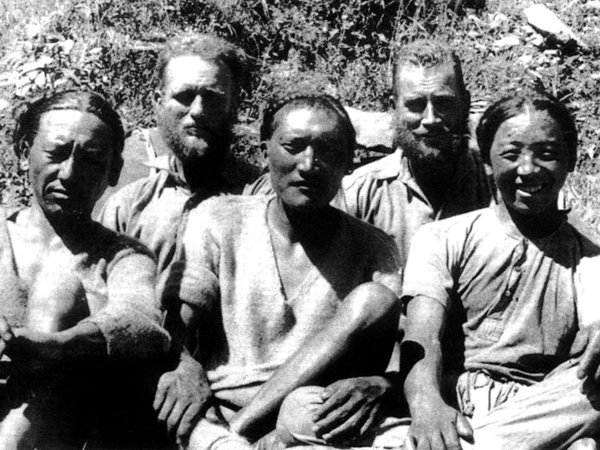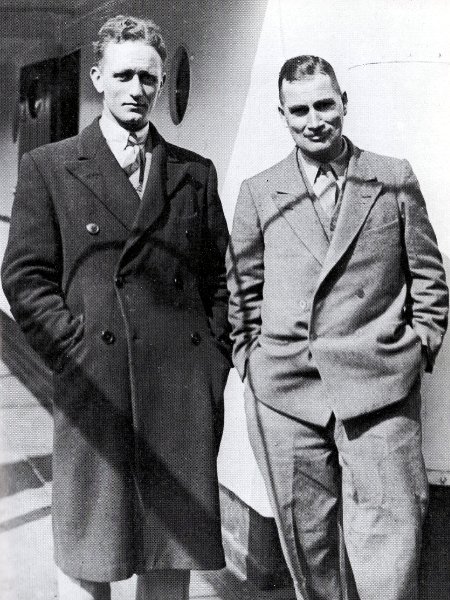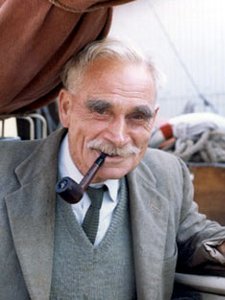A little while ago I explained how I was working through the second draft of the book I’m writing about my journey from hill walker to Everest summiteer, and editing the eye-watering 180,000 words I’d written for the first draft down to a more manageable 120,000. I explained how much of the historical background I originally wrote about the peaks I climbed and places I travelled to along the way, I was in the process of chopping out of the book because, while interesting, they weren’t essential to the flow of the story. Instead they would make good topics for blog posts, since I’m frequently writing about mountaineering history here, and many of you will be interested. Here’s the second post in that series, which follows on from the first one about how Nepal came to open its doors to tourism.

And remember, if you like what you read here, the content I decide to leave in the book will be even better.
Nepal’s first genuine trekking tourist was the great mountain explorer Bill Tilman. Born near Liverpool in 1898, Tilman’s introduction to high mountains came relatively late in life, but he certainly made up for lost time. He was in his early 30s and working as a plantation owner in Kenya, on land he had acquired in an unusual fashion. After surviving the First World War in active service as an artillery officer at both the Battle of the Somme and Passchendaele he was awarded a square mile of land on the edge of the Mau Forest, in what was then British East Africa, as part of a government scheme for resettling demobbed soldiers.
He had been there eleven years and was making a reasonable living when he read about the climbing exploits of another plantation owner, Eric Shipton. Intrigued but having no climbing experience, Tilman wrote to Shipton asking if he could accompany him on some of his climbs. Shipton agreed, and the pair of them climbed Kilimanjaro and Mt Kenya together, and completed some ascents of the Rwenzori Mountains in Uganda. Despite his inexperience Shipton found Tilman the ideal climbing partner: taciturn, strong, fearless, and able to endure any form of hardship with stoicism.
Bored with life in Africa, Tilman eventually sold his farm, bought a push bike and departed in bizarre fashion, pedalling all the way through the jungles of the Congo from Uganda to the west coast, living almost entirely on a diet of bananas. Legend has it he arrived back in Liverpool by cargo ship and was at a loose end and wondering what to do with his life, so he wrote to Shipton asking if he fancied a couple of weeks’ climbing in the Lake District. By then Shipton had made a name for himself as a mountaineer of some repute, having been a member of the team who made the first ascent of 7756m Kamet in India’s Garhwal Himalaya, at the time the highest mountain that had ever been climbed, and taking a prominent role in the 1933 British Everest expedition. He was in the process of organising a shoestring expedition to Nanda Devi, but was having trouble finding a partner prepared to tolerate the austerities when Tilman’s letter arrived fortuitously on his desk.
“I replied with a counter proposal that he should join me on a seven month trip to the Himalaya,” Shipton said laconically in his autobiography.

Tilman accepted without hesitation, and one of the great partnerships in Himalayan exploration was born. The pair became linchpins of the industrial-scale Everest expeditions of the 1930s, taking it in turns to share the leadership. But they were better known for pioneering a new lighter style of Himalayan expedition, exploratory trips involving a small group of climbers with their trusty Darjeeling Sherpas, living cheaply off the land. They boasted they could organise an expedition on the back of an envelope, and came to despise what they saw as the unnecessary opulence of the Everest expeditions, but they didn’t feel they could refuse the invitations of the Mount Everest Committee when they came.
Tilman acquired the reputation of being a taciturn introvert who sometimes found relationships awkward. At the end of the Nanda Devi expedition, after spending seven months sharing tents, meals and many adventures with him, Shipton said they were still calling each other Shipton and Tilman instead of Eric and Bill.
“When … I suggested that it was time he called me ‘Eric’ he became acutely embarrassed, hung his head and muttered, ‘It sounds so damned silly.'”
When Tilman reached the summit of 7816m Nanda Devi with Noel Odell in 1936 his reaction was unusual, and very different from celebrations we are accustomed to seeing nowadays. He didn’t plant his ice axe in the snow to one side, pretend it was a corner flag and run towards it with his shirt lifted over his head to reveal a vest emblazoned with the slogan This one’s for you, Wazza. He didn’t prance around the axe in some embarrassing travesty of a robotics dance before falling on his back to be straddled by Odell firmly intent on planting a big juicy kiss on his forehead. No, Premiership footballers take note: he had just reached the summit of the highest mountain that had ever been climbed after a two month expedition, having first found a route to the summit on an exploratory trip with Shipton two years earlier. It wasn’t something people did every week, like knocking a measly spherical bit of leather into the back of a net. So what did he do to celebrate? He tells us precisely what he did in his book, The Ascent of Nanda Devi.
“I believe we so far forgot ourselves as to shake hands on it.”
If only young people these days would exercise as much restraint.
While Shipton had a reputation as a bit of a ladies’ man who laid his ice axe alongside many a memsahib’s bed while travelling across India (or to use modern parlance, he shagged around), Tilman was quite the reverse. Although there’s not a shred of evidence he was gay – the many men he shared a tent or close quarters with during his years in the army or on expeditions are testament to this – he went out of his way to avoid the company of women. Some people believe Tilman was a misogynist, but in reality his extreme shyness and independent lifestyle probably caused him to be a little bit scared of women. He provides a great example of his and Shipton’s contrasting attitudes in his book Snow on the Equator. There was a long delay to their plans when they stopped and waited to help a woman whose car had broken down.
“It was a case of a assisting a damsel in distress, so the delay was suffered gladly by one of us, and by the other without impatience.”

After he retired from mountaineering Tilman bought a boat and spent the rest of his life sailing around the world, mostly in polar waters. Although he often had great difficulty recruiting crews he never once accepted a woman crew member because he believed they might wheedle the rest of the crew into ganging up on him. At times his fear of women is slightly comical.
“I did not care to run the risk of being talked or ogled into an act of folly,” he once said.
One of his advertisements for a crew famously said:
“Hand (man) wanted for long voyage in small boat.”
This didn’t stop women from applying, and on one occasion he even received an enquiry from a married couple (“an application which made me wince,” he remarked). In 1950 he was invited to join some American friends on a brief exploration of the Khumbu region, the first ever by westerners, and such was his eagerness to see the south side of Everest that he couldn’t refuse, even when he learned one of his companions was to be a Mrs Betsy Cowles.
“Hitherto I had not regarded a woman as an indispensable part of the equipage of a Himalayan journey,” he says somewhat whimsically in Nepal Himalaya. Mrs Cowles eventually won him over.
When Nepal finally opened its doors to foreigners at the end of the 1940s they started off by allowing in a few scientists. Tilman was the first person allowed in for the purpose of exploration and general sightseeing, though the government of Nepal stipulated that the expedition had to include scientists. This is something that would also have made Tilman wince. One comical element to his book The Ascent of Nanda Devi is his hatred of the enormous glacier drill geologist Noel Odell took with him.
Tilman ended up making three treks to Nepal between 1949 and 1950, in Langtang, the Annapurnas and the Khumbu (Everest) region. They were to be his very last mountain reconnaissances before he bought his boat Mischief and took up sailing instead. In part three of this series I will talk about his expedition to Langtang.
I hope to publish my book later this year, but in the meantime you may be interested to know my travel diaries are now available as ebooks for the bargain price of just a single $, £ or € depending on your currency. They’re a little more rough around the edges than the book will be, but if you don’t mind that, you enjoy some of my jokes and have a few coins to spare then please take a look. They are available from most of the main ebook retailers including Amazon.







Hi Mark,
I stumbled on your site looking for books about Bill Tilman. I know this sounds totally crazy, but id never heard of him until he appeared in a shamanic journey and is apparently a spirit guide to me. yeah the midwesterner in me cringes but the incident is beyond belief. I picked up his name, his face, that he was a writer and mountaineer, european, his clothing, the mustache, we talked about his pipe smoking. so on a whim I google the name, and lo and behold THERE HE IS. exactly as I had seen him a real person. He speaks little, but the energy I get is indescribable. Im looking for everything I can find about him now….. can’t believe the irony that you posted this today….
I look forward to reading more of your adventures! Peace and THANKS.. Lisa
Yes, that’s right. Tilman was famously taciturn. Heehee, that’s fantastic. Perhaps my blog is now giving off magic powers! Thanks so much for commenting, you’ve made my day. 😉
Eric Shipton & Bill Tilman….fantastic lives, fantastic books, Blank On The Map etc.
They don’t make ’em like that anymore.
yeah I was pretty freaked out to have this experience, let alone admit it, but so far what I’m learning about him is super exciting to me. sounds like Ive got quite a badass guardian! Thanks for the great info. I’ll look for Blank On The Map… and would love to hear more recommendations
and of COURSE the blog is giving off magic powers!!! or at least directional signposts… ha!
Hi Lisa,
Blank on the Map is one of Eric Shipton’s books, although Tilman was on the same expedition and features prominently in it.
Conveniently all of Tilman’s books are available in two handy volumes for his early mountaineering and later sailing careers if you’re able to track them down:
The 7 Mountain Travel Books:
http://www.goodreads.com/book/show/1763616
The 8 Sailing/Mountain Exploration Books:
http://www.goodreads.com/book/show/1763613
My personal favourites are Snow on the Equator and Nepal Himalaya for their whimsical old school British humour, although many consider The Ascent of Nanda Devi his best work (at the time the highest mountain that had ever been climbed).
Enjoy! You have a feast ahead of you. I hope to read them all again some time too.
Regards,
Mark.
Mark Thanks Again!!!
i had seen several of his titles on a wiki list but didn’t know about these compiled volumes. Placed the order this morning. I can’t wait to take off on wild journeys! if only in my dreams.
So what are you top 3 faves of your own work? working on my collection 🙂
many thanks, Lisa
Gosh, you’re thinking of reading my own rough and ready travel diaries alongside Tilman’s great travel books? I’m not sure I can handle that 😮
Perhaps other readers of this blog are better placed to answer that question than I am. Otherwise you could try my Everest diary The Chomolungma Diaries (https://www.markhorrell.com/diaries/chomolungma.html), which took place on the north side of Everest, just as Tilman’s expeditions of the 1930s did. Two other journeys which took me in his footsteps are described in Snowshoes and Shipton (https://www.markhorrell.com/diaries/snowshoes.html) and The Summit Prince of Braga (https://www.markhorrell.com/diaries/prince.html). A word of warning though: my jokes are not to everyone’s taste 😉
My father… Bill Packard… Was one of the members of Tilmans Annapurna expedition, as the much resented scientist. He always told us how as soon as the expedition was on its way, Tilman dumped the scientific equipment in a ditch and led the small group off to climb something, anything unclimbed, ideally above 8,000 metres. With almost no equipment, food or support they almost were the first to reach the summit of Annapurna IV, making it within a few hundred metres of the peak.
After that Tilman left the rest of the group and headed off to do further scouting/exploring. He certainly was a unique man
Thanks for dropping by my blog and leaving a comment, Hugh. Nice to get some insight (almost) from the horse’s mouth. Your father gets a mention in my post next week about the Annapurna expedition. According to Tilman’s account he was the star on Annapurna IV, and might have reached the summit had he not run out of climbing partners!
Hi Mark, just tripped over your blog as a result of some random Tilman related googling. Fascinating reading, thanks for putting it up. I’m one of the ‘eccentric’ few Tilman crewmembers who returned for a second voyage. Actually, there were eight of us in all over the years. We remained friends over the years until his ill-fated trip south in 1977. I can tell you with some confidence that he’d have enjoyed your posts.
Kind regards
Bob
Thanks so much for posting, Bob. Your name rings a bell. I’m glad you enjoyed reading, and your last sentence has made my day!
Tashideleg /Namaste Mark
Well I am very interested to first trekkers in Nepal Bill T…it is great history for the adventures people…I would like to just ask how do recommend/suggest for comming new generations tourism in Nepal …
After nature catastrophes and this roughly situation…we are glad to hear from you..
With kinds regard from Himalaya
Gelu Sherpa
Mark, enjoyed your writing of H.W. ” Bill” Tillman.
I’ve read his books.
I often passed by the house he shared with his sister in Barmouth, when taking OBWales clients climbing at Barmouth Slabs.
I will look up your book..
I randomly clicked on an article about HWT a few months ago and since then have fallen down quite a rabbit hole. I find him endlessly fascinating – his exploits were quite larger than life but he was also very human and so remains accessible, not as a godlike figure.
Lisa’s story is quite intriguing – not sure what a shamanic journey or guide really entail — I wonder if Lisa has had adventures of her own in the years since.
Thank you for your article series Mark! It’s encouraged me to read the books for myself. One impression (unrelated to the author) from the writing and photos is that there was so much more snow and ice on the mountains back then! It’s a diminished world we live in…